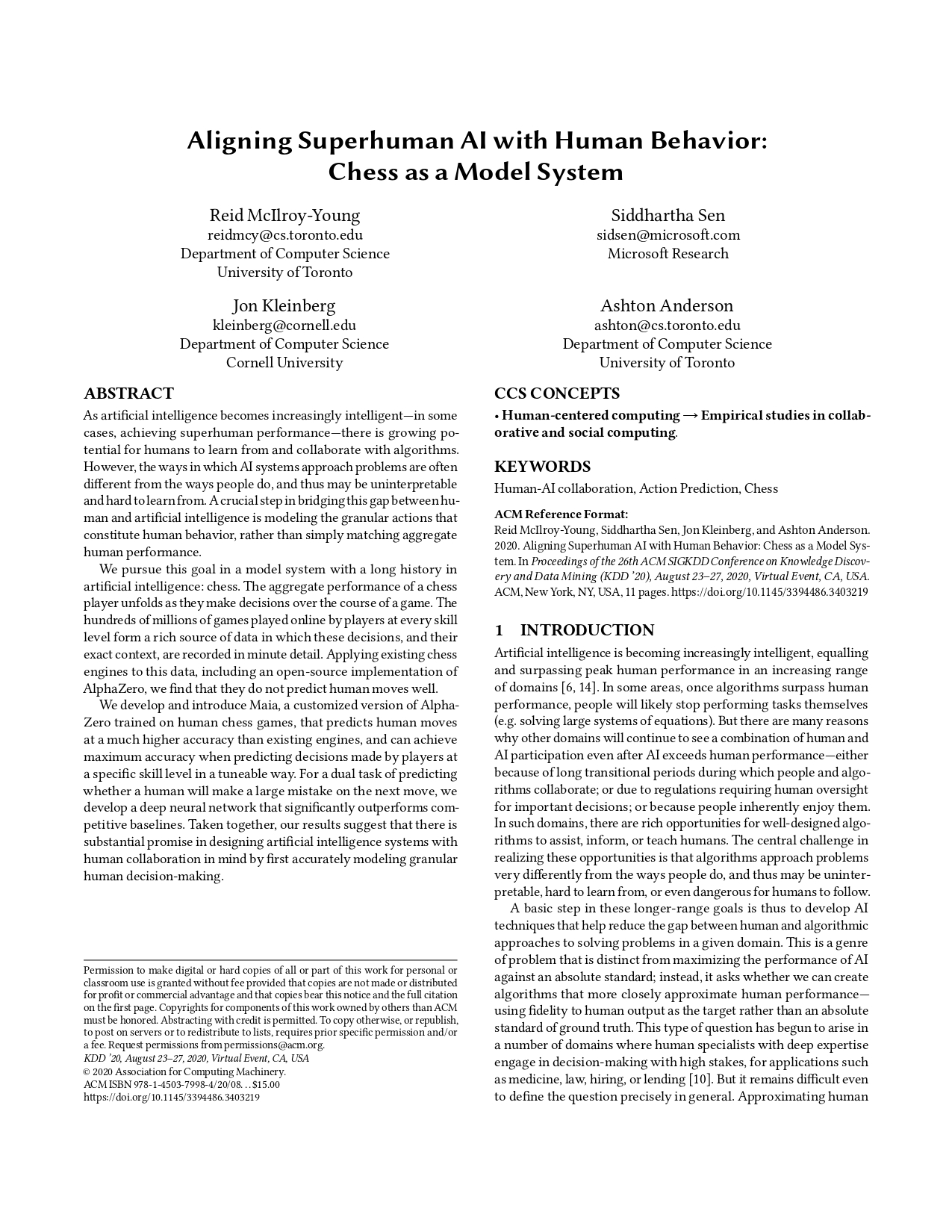Human-AI Collaboration for Chess
What is Maia Chess?
Maia is a human-like chess engine, designed to play like a human instead of playing the strongest moves. Maia uses the same deep learning techniques that power superhuman chess engines, but with a novel approach: Maia is trained to play like a human rather than to win.
Maia is trained to predict human moves rather than to find the optimal move in a position. As a result, Maia exhibits common human biases and makes many of the same mistakes that humans make. We have trained a set of nine neural network engines, each targeting a specific rating level on the Lichess.org rating scale, from 1100 to 1900.
We introduced Maia in our paper that appeared at KDD 2020, and Maia 2 in our paper that appeared at NeurIPS 2024.

Aligning Superhuman AI with Human Behavior: Chess as a Model System
This paper introduces Maia, a chess engine trained to imitate real human moves at different rating levels. Instead of always picking the best move, Maia predicts what a human player of a given skill would actually play. This makes it ideal for training, game analysis, and even coaching, as it helps players learn from realistic decisions rather than computer perfection. It was the first AI to prioritize human-likeness over engine strength, making it a powerful tool for improvement.

Maia‑2: A Unified Model for Human‑AI Alignment in Chess
Maia‑2 is the evolution of Maia into a single model that can simulate any skill level in chess. Instead of using separate models for different ratings, it understands and adapts to your level in real time. Whether you're a beginner or a master, Maia‑2 predicts the moves players like you would actually make. It's built to feel human, teach naturally, and support personalized analysis without needing to toggle between bots.
Learning to Imitate with Less: Efficient Individual Behavior Modeling in Chess
Captures the way you think on the board, allowing bots to mirror your personal play-style from just 20 of your games.
Detecting Individual Decision‑Making Style: Exploring Behavioral Stylometry in Chess
Shows that your chess style is as unique as a fingerprint, allowing the model to recognize you just by your move choices.

Aligning Superhuman AI with Human Behavior: Chess as a Model System
This paper introduces Maia, a chess engine trained to imitate real human moves at different rating levels. Instead of always picking the best move, Maia predicts what a human player of a given skill would actually play. This makes it ideal for training, game analysis, and even coaching, as it helps players learn from realistic decisions rather than computer perfection. It was the first AI to prioritize human-likeness over engine strength, making it a powerful tool for improvement.

Maia‑2: A Unified Model for Human‑AI Alignment in Chess
Maia‑2 is the evolution of Maia into a single model that can simulate any skill level in chess. Instead of using separate models for different ratings, it understands and adapts to your level in real time. Whether you're a beginner or a master, Maia‑2 predicts the moves players like you would actually make. It's built to feel human, teach naturally, and support personalized analysis without needing to toggle between bots.
Learning to Imitate with Less: Efficient Individual Behavior Modeling in Chess
Captures the way you think on the board, allowing bots to mirror your personal play-style from just 20 of your games.
Detecting Individual Decision‑Making Style: Exploring Behavioral Stylometry in Chess
Shows that your chess style is as unique as a fingerprint, allowing the model to recognize you just by your move choices.








